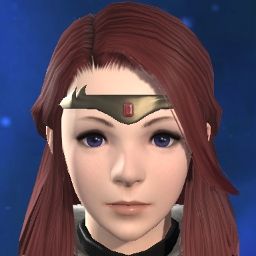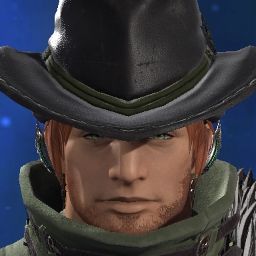1. Elidibus is the original and thus is, in effect, Zodiark, much like Ysayle was Shiva etc., and that for whatever reason, he was not sundered when Zodiark was split. I also don't think he's tempered if this is the case, and that distinguishes him from the other Ascians.
If I’m wrong, I could see Zenos as the original’s sundered Source shard, perhaps bearing the name “Sabik”, and Elidibus as either the “diplomatic ancient” (assuming the summoners did not die) or the 14th, assuming they’re just baiting us into thinking that it’s the main character.
2. I'm going with Elidibus’s true name – if he has one like Hades - being Ze(ro)mus. Although it's not a 1:1 match up, much like Venat doesn't appear to be one either for XII's version for now, there's enough inspiration for it to fit loosely. Gerun also seems like a good guess, and at the very least, the Japanese version of the
Gerun Oracles is consistent with the lore we have now on the two eldest of primals, even if the other versions do read as somewhat false in certain of their details.
3. Their plan is to rejoin the Void (13th) and First both at once, with the aspiration that the collision of light and dark corrupted aether will neutralise the effect of both in the aether in each world and then flow into the Source, perhaps with Unukalhai and Cyella as “anchors” for the Void in their respective locations (Source, First.) My guess is that they were using Eden to quicken the process so that their aether is in a ready state for the merger. Although the Void is thought to be bereft of aether, this is solely based on measurements taken by NOAH... if darkness places the aether in a high state of agitation, it could be that their measurements simply weren't calibrated correctly to pick it up.
4. The equilibrium Elidibus refers to relates to the effect Zodiark and Hydaelyn have on the Lifestream itself. This is sort of based on
“known” lore, but obviously ShB has shown, this can be wrong/inaccurate, and much of what we know is, ultimately, a matter of in-world character knowledge, so it is fallible. Nonetheless, that part of it, about the light/dark balance in the Lifestream, probably holds up. My guess is that there is an intersection of the Lifestream/Aetherial Sea where Hydaelyn is
thought to be situated, at some point in the centre of the planet, and her effect on it is to shift the balance towards light.
What happens in the aetherial realm affects the corporeal realm, so knowing what we do now about light, my best guess is that she exerts a pacifying effect on the planet's aether (consistent with Leveva's comments on what she beheld when she gazed upon the star below) and possibly the formation of new lifeforms (thus Elidibus's remarks about the waning of the souls, and Lahabrea's comments on her as a parasite, plus his comments on the eventual fate of laws both aetheric and physical.)
I also think the sundered state of the shards plays into this, as it’s unclear how it affected the way in which the Aetherial Sea interacts with them, and when you add in considerations like the passage of time between these worlds being different, having the shards segmented in this way might be damaging to the balance within the Aetherial Sea itself, if it hasn’t just sliced it up like a pizza and thus reduced its aetheric concentration. It's also unclear whether this Lifestream also extends to other planets - my thought is it could be like a river across the rift, with the "Mothercrystal" acting like a localised whirlpool of aether and souls for each star, keeping them in its "orbit".
Additionally, based on the dialogues with Emet-Selch
here, plus the 5.1 lore on tempering, my surmisal is that its role is not so much to bind individuals to the Primal's will, as it is to set up an energy network for it, in order to spread its domain and possibly provide it with a baseline of aether through its summoners. The total brainwashing we see in some instances, and more nuanced forms of mind control in others, suggest it varies based on the being it hits - add in a "heart" like Venat or Elidibus, and you probably have a situation like Thordan, where it takes an active exertion of will to be used in this way. The presence of this may allow a greater measure of control over the Primal and prevent it from running amok.
5. I’m of two minds on the ultimate cause of what led to the disagreement which led to Hydaelyn's summoning, but there are two possibilities which make the most sense to me.
Taking Hydaelyn’s version of events as at least partially true, there may have been concerns that Zodiark would grow too powerful (and this in turn would somehow result in their doom being visited upon them again.) It's possible it all had to do with the effect of the Primal on the aetheric balance of the Lifestream itself (as per 4).
Still, there’s some lingering doubts about that. For one, Hythlodaeus framed the disagreement as culminating from their differing stance on how to deal with the new life that came after Zodiark repaired the planet. Yet this is not mentioned in the scene right before the summoning – instead, the rationale Emet proposed was mentioned. My thinking is there might be a link between the two things. The notable things about their meeting to me were that they did not mention tempering, did not mention the proposed final stage of sacrifices, and did not doubt the Convocation's motives. What they
did cite as a reason was their belief that Zodiark was not a permanent solution to the Final Days, and so they were moved to summon the light that would keep the darkness in check.
Zodiark was being used as the means by which the Convocation would restore the ancients who were sacrificed to bring him about and restore the world, in order that they could resume their stewardship of the star. If the reason the Convocation did not deem these new lives to be suitable stewards for the planet, it may well have been because they were deficient in their potential for creation magicks - if the opposing faction blamed these for the crisis, this would appear as a bonus, and it would likely seem plausible to them if they never got to the bottom of what caused the Final Days. Thus, perhaps Venat's faction attributed blame for the Final Days to creation magicks and "checking" Zodiark's darkness had the goal of preventing the return of the ancients, and thus ultimately removing the risk they thought creation magicks posed.
There is also Elidibus at the end of 5.0 stating it was intended by Hydaelyn and her summoners that the present lifeforms would have no memory of their past. Leaving aside how he came about that knowledge, it does seem consistent with the notion that they wanted to gradually replace the ancients with beings lacking this potential.
That said, it's also possible that their long, long lifespans meant the Convocation wished to speed matters up in order to rebuild their civilisation as soon as possible, and that this is where the plan to restore their fallen came into it, rather than wait several thousands of years for the "new life" to mature.
Whichever version it is, once they got locked into battle, they would not back down, and I imagine Zodiark would not take kindly to such an unexpected imposition - it's possible this led their state of mind to become muddled.
I just hope they avoid the route of going with Zodiark deceiving the ancients/Convocation into making sacrifices to him, to revive the fallen, with no intention of ever bringing them back but just to secure more aether. The tone of Venat's congregation's dialogue, and the fact that Zodiark was already the "Will" in the star and had access to all its aether, should mean this was not necessary in the first place, but it's still a conceivable story route, albeit one I'd prefer them to avoid. Basically, "creation magicks dun it" (=were the ultimate cause of the Final Days) and "Zodiark bad" are the two things that would weaken the story for me. As things stand, you have two factions with understandable motives and conflicting perspectives, which makes it engaging.
As an aside, the
Totentanz from the DNC job quests does have some slight parallels to it, but given how the Amaurotine NPC puts such emphasis on the precipitating keening sound, it's not an exact parallel.
6. In a similar vein, the troubles plaguing Amaurot and the ancient world began within the Lifestream/the "Underworld" - if the inner planet has an affinity to it, such that it intersects with it most strongly at various points inside the planet, it'd fit with the origin point of the sound being beneath the ground. I have an inkling that this started at least as far back as Hades’s
short story, where the soul unexpectedly attaches itself to the firebird, since this was aberrant behaviour, even if not unprecedented.
My guess/hope is they go with some manner of entity that managed to invade via the Underworld, particularly given the potential it'd have for future storylines. Assuming such a thing, the 14th left the Convocation in pursuit of the ultimate cause of the Final Days, so as to provide the Convocation with an alternative solution, but remained MIA when approached by Venat's faction. Entering the world through the Underworld would also provide a ready avenue of retreat, to avoid the Sundering, assuming it was not imprisoned in a similar way to how the High Seraph was.
Although a storyline whereby their powers somehow taxed the world too much is certainly possible, for a race of beings so attuned to aether itself, and souls flowing within the Lifestream, I find it difficult to believe this would completely elude them, particularly since their civilisation was long-standing by all appearances and cautious in its regulation of the usage of creation magicks.
7. "Asahi" and the identity of who the final boss will be are difficult to say. On the white robed guy, I'm just going to go with it being uncharacteristic of Elidibus to simply leave Zenos as a wildcard, and given that he used Zenos's form to influence Asahi in SB, it seems fitting a minion of his would use Asahi's form to do the same to Zenos. The fact that his soul's hue stood out to Zenos when he scried his soul makes me think he is another a shard of the main character, whoever he might be. The XII Venat reference angle (be it Venat or a minion of hers) is cool and all, and could make for some very interesting writing and may well be the case, but there's too little in the plot right now to suggest that is who he is.
For the final boss, Exarch would be my main pick, possibly some crystallised fusion with the Crystal Tower, followed by Zenos as a less likely option - I think they might instead reserve him for 6.0 and Zodiark (possibly Hydaelyn too) for 6.3. G’raha is an easy pick for the memory transference reasons others mentioned.
8. The Queen of Blades will take inspiration from Asura, what with Gabranth being Legatus of the 4th, Asura featuring in Vagrant Story and with the "limbs" on either side of the body being consistent with an aspect facing left and another rightwards. I am guessing they will give her a XII Ultima flair, though. I had hoped they'd pick up on the High Seraph and embellish her lore a bit further, and who knows, maybe it'll serve as a battery for another Primal, but the evidence does seem to point towards Asura.
9. I doubt this will show up in 5.3, but I believe Sharlayan is inspired by memories of Amaurot, perhaps drawn from the Lifestream, and the Twelve were a collective memory of the Convocation, spurred by the Ascians’ early attempts to see what could be done with the sundered lifeforms, i.e. they were the “gods” that walked the earth during the First era, with the sundered Overlords gradually arising as a shard of theirs was enlisted – probably each from one of the shards they intended to rejoin due to some benefit this link provided. I also think the Chrysalis is the off-world site/plane where the Convocation took to to summon Zodiark, given the precarious state of the world, and where at least two of the unsundered escaped to when things became unsalvageable.
Lastly, I am curious whether they will expand on the lore behind the auspices and perhaps link it to the ancients, with their immense lifespans.








 Reply With Quote
Reply With Quote











